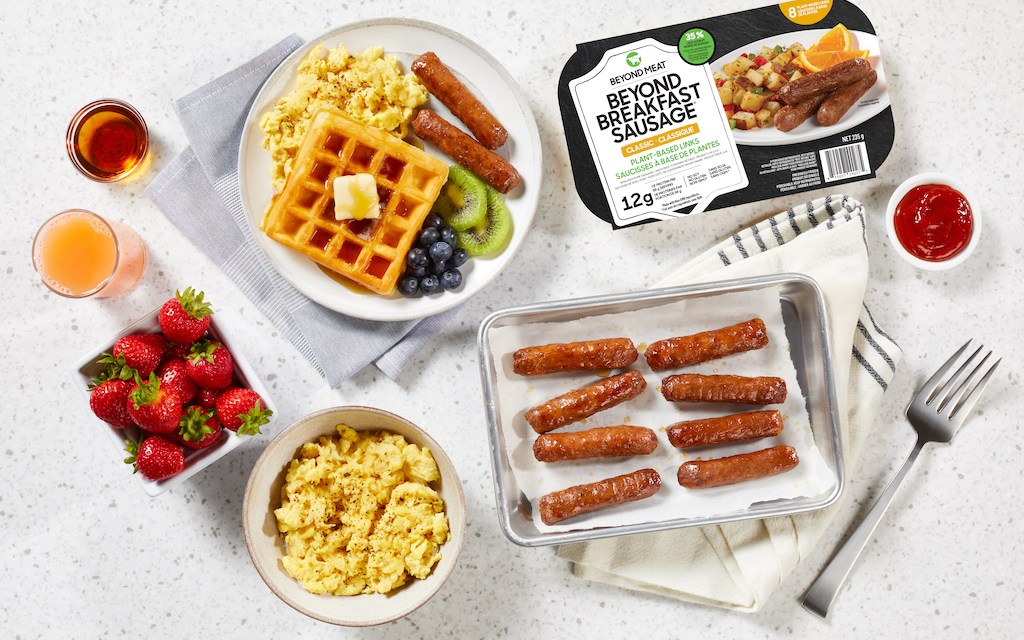As losses mount, Beyond Meat is losing its luster

Beyond Meat continues to struggle with profitability and growing losses.
The meat alternative maker, which went public in 2019, has had trouble maintaining its status as the leader in the alternative protein category. In the first half of the fiscal year 2022, Beyond’s net losses quadrupled year-over-year, to $197.6 million. In turn, investors have been cool on the company, with Beyond Meat’s stock down nearly 80% this year, from $65 to $13.
Beyond Meat reported its fiscal third-quarter earnings on Wednesday, revealing revenue of $82.5 million, a 22.5% drop year-over-year. Meanwhile, quarterly net losses came to $101.7 million, or $1.60 per share. Like previous quarters, Beyond Meat attributed the negative results to a drop in both retail and foodservice channels for its products. The decrease in revenue, for instance, was “driven by a 12.8% decrease in total pounds sold and an approximately 11.2% decrease in net revenue per pound.”
Still, Beyond Meat is hopeful it will achieve profitability in the coming year.
In October, the company announced a goal of becoming cash flow positive by the end of 2023 — and with that will come aggressive tactics to trim operating costs. This will include mass layoffs, potentially letting go 19% of its workforce, according to the company. In the latest earnings’ release statement, Beyond Meat founder and CEO Ethan Brown reiterated these plans.
“Beyond Meat is executing a full force pivot to a sustainable growth model, emphasizing the achievement of cash flow positive operations within the second half of 2023,” Brown said. “This transition is designed to fortify our business in the near-term as record inflation continues to pose a challenge for our brand and category, positioning Beyond Meat to endure and advance toward our long-term objective of being a major protein provider within the $1.4 trillion meat industry.”
Much of Beyond’s ongoing woes are due to retailers’ drop in plant-based product orders, which comes as a result of shoppers opting for cheaper protein brands. The company has also said that it’s increasingly facing increased costs of raw material, manufacturing and logistics. Not to mention, more food startups, along with meat giants like Tyson Foods, continue to enter the market.
Ad position: web_incontent_pos1
“I’m not all that surprised by the results,” said Jonah Ellin, chief product officer at 1010data. Ellin noted that while the meatless protein category itself will continue to gain traction over time, it’s no longer experiencing the meteoric rise it did in past years — especially as consumer interest has leveled off amid this year’s inflationary period.
After growing as a publicly-traded company between 2019 and 2020, Beyond Meat’s valuation began to drop along with its revenue growth rate. In 2019, the company’s valuation hit an all-time high of $3.8 billion — it has since deflated to less than a billion. During its peak, Beyond’s market cap was estimated to be $13.85 billion. Today, that figure has dropped down to about $752.55 million.
“When they came out, Beyond Meat was the product,” Ellin explained. Not to mention, there are now countless meatless protein alternatives that customers are seeking out. “They’re no longer exclusively looking for the Beyond name.” With Beyond’s packaged burgers costing around the same as standard meat these days, Ellin said it can be a hard sell for many households cutting back on meat to save money.
Some of Beyond Meat’s newest initiatives, meant to diversify its retail offerings, are already impacting its bottom line. Beyond’s plant-based jerky collaboration with PepsiCo, part of its The Planet Partnership, resulted in a loss of $7.7 million in gross profit. This past quarter, the jerky’s venture resulted in approximately $5.9 million of added costs, according to the earnings report.
On the other hand, Beyond Meat has an opportunity to return to its premium roots, Ellin said. For instance, the company just announced a plant-based steak, which Ellin said could help it attract higher end grocery shoppers.
Ad position: web_incontent_pos2
“Hopefully, they’ll drive enough volume to offset losses from these investments,” Ellin said. “The challenge is to get people to consistently buy their products over and over.”

